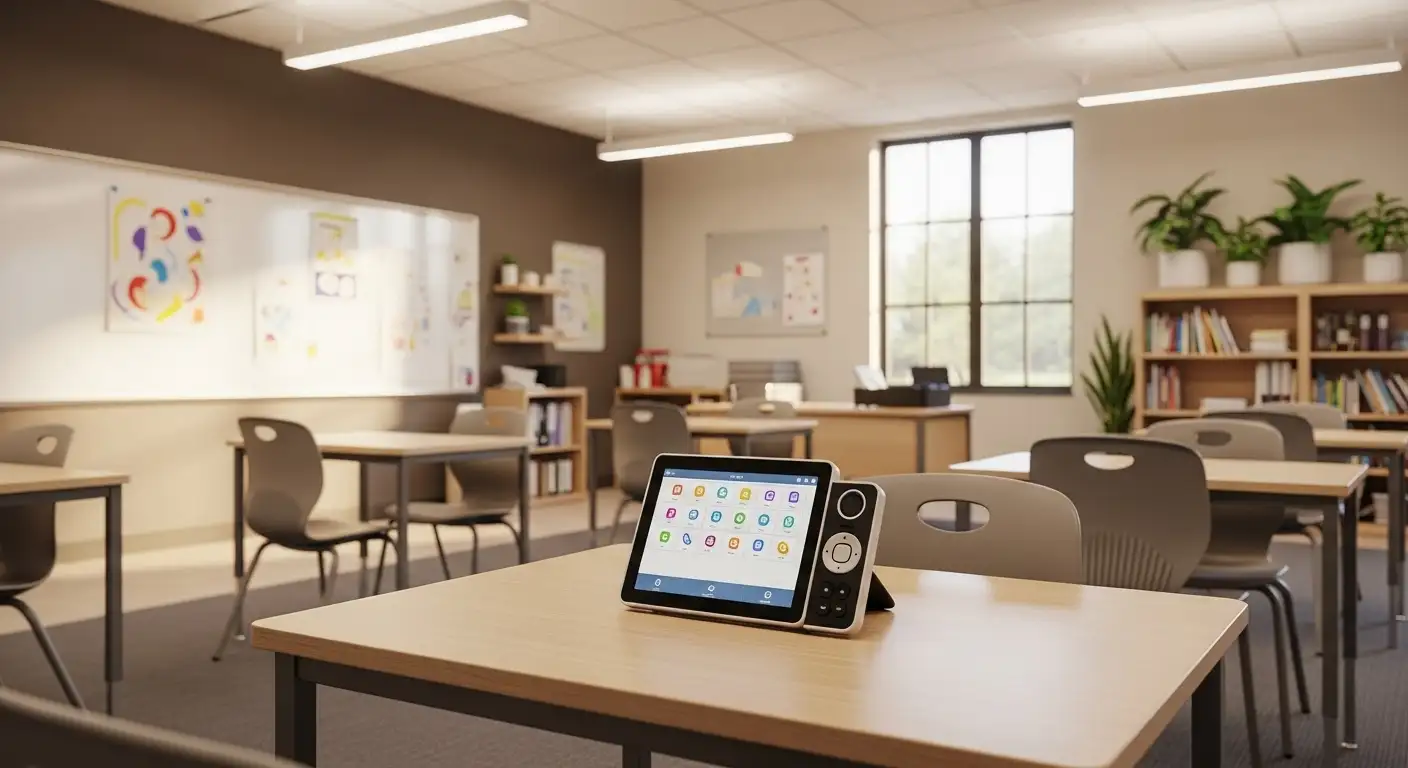Tips for Encouraging Speech Device Usage in Daily Life


Unlocking the Full Potential of Speech Devices
Effective communication is fundamental to a child’s development and daily success. For children who benefit from augmentative and alternative communication (AAC) devices, integrating these tools into everyday routines is essential. This article explores expert-backed strategies to encourage consistent and meaningful usage of speech devices throughout daily life, ensuring communication support is practical, personalized, and empowering.
Understanding the Role of AAC Devices in Daily Communication

What is the Purpose of Speech Devices?
Speech devices, often referred to as Augmentative and Alternative Communication (AAC) devices, serve as essential tools to help children with communication challenges express their needs, thoughts, and emotions. These devices range from low-tech picture boards to high-tech speech-generating devices, enabling users to communicate effectively when verbal speech is limited or absent.
How Does AAC Support Children with Communication Challenges?
AAC devices are integrated into natural daily routines within ABA-based day programs, providing children with Autism Spectrum Disorder (ASD) practical ways to communicate during activities such as dressing, playtime, and transitions. Using visuals, prompts, and functional communication training, these tools reduce frustration and meltdowns by offering children consistent and accessible methods to express themselves.
Connection to ABA Therapy and Speech-Language Pathology
ABA therapy systematically incorporates AAC to enhance communication skills through techniques like discrete trial training and natural environment training. Collaboration between ABA therapists and speech-language pathologists (SLPs) ensures that communication approaches are personalized and embedded into the child's daily routines. SLPs, as part of multidisciplinary teams, support the effective use of AAC devices, tailoring interventions that promote speech and language development while fostering independence.
By embedding AAC within structured programs and daily activities, children with communication difficulties gain meaningful opportunities to develop and generalize communication skills, vital for their social and adaptive growth.
Embedding AAC Device Usage into Natural Daytime Routines
How are speech devices used during dressing, handwashing, and transitions?
Speech devices, or Augmentative and Alternative Communication (AAC) tools, are seamlessly integrated into daily routines like dressing, handwashing, and transitions in ABA-based day programs. These natural settings provide children with autism spectrum disorder (ASD) the opportunity to use communication devices to express needs, make choices, or seek assistance, which helps reduce frustration and the likelihood of challenging behavior.
For example, during dressing, children can use AAC devices to select clothing options or request help. When washing hands, devices can prompt children to communicate the steps or indicate readiness. Transitions between activities offer chances to request breaks or clarify schedules, supported by the predictable routine.
How are speech devices incorporated in predictable routines and real-life skill building?
Because day programs are built around predictable structures, AAC integration becomes part of habitual practice, allowing children to grow accustomed to using devices in various contexts. Predictability helps children anticipate communication opportunities and reduces anxiety, making AAC use more natural and effective.
AAC devices support real-life skill acquisition by embedding communication within meaningful tasks. Visual supports, prompts, and reinforcement encourage consistent device use, ensuring communication skills generalize beyond therapy sessions.
What are some natural opportunities for practicing communication using AAC?
Natural opportunities arise frequently throughout the day. Some examples include:
- Group Play: Using devices to initiate or respond during interactive games and turn-taking.
- Snack Time: Indicating food preferences or requesting utensils through AAC apps.
- Transitions: Communicating feelings about moving from one activity to another or requesting extra time.
- Routine Tasks: Expressing choices during handwashing or dressing promotes independence and conversational practice.
Embedding AAC devices into daily life empowers children to practice communication organically, fostering skill generalization and boosting confidence.
Collaborative Multidisciplinary Approaches to Support AAC Integration
Team involvement: ABA therapists, SLPs, occupational therapists
Successful integration of Augmentative and Alternative Communication (AAC) devices relies on a collaborative team approach. ABA therapists, speech-language pathologists (SLPs), and occupational therapists work together to support children with autism spectrum disorder (ASD) in day programs. Each professional brings unique expertise: ABA therapists focus on behavior and skill acquisition, SLPs provide expertise in communication development, and occupational therapists address fine motor and sensory needs that impact AAC use.
Shared goals and communication strategies
These professionals establish shared goals tailored to each child’s individualized needs. Regular team communication ensures consistency in teaching methods and reinforcement strategies. Shared planning helps embed AAC use throughout daily routines—from dressing and handwashing to group play and transitions—making communication functional and relevant in real-life contexts.
Collaborative planning to address sensory, communication, and behavior
Integrated strategies often combine sensory regulation, communication techniques, and behavior management to facilitate smoother AAC implementation. For example, sensory supports can reduce frustration that might interfere with a child's ability to use an AAC device effectively. Behavior interventions by ABA therapists help teach appropriate communication responses, while SLPs guide the use of AAC tools and visual supports.
This multidisciplinary collaboration enhances the effectiveness of AAC integration by promoting consistent use across settings and ensuring that therapy is personalized and family-centered, ultimately supporting greater communication independence and reduced challenging behaviors.
Leveraging ABA Techniques to Promote Speech Device Engagement

What Are Discrete Trial Training (DTT) and Natural Environment Training (NET)?
ABA therapy uses Discrete Trial Training (DTT) to teach skills through a structured approach. DTT breaks down speech device use into small, manageable steps, providing clear instructions and prompts. Each step is followed by reinforcement when the child successfully engages with the device. This method helps children learn specific communication functions in a controlled way.
Natural Environment Training (NET) complements this by encouraging children to use speech devices in everyday settings. For example, a child might practice asking for a toy or a snack using an AAC device during playtime or snack time. This helps them generalize skills learned during DTT to real-life situations and increases spontaneous communication.
How Does Functional Communication Training (FCT) Replace Challenging Behavior?
Functional Communication Training (FCT) is used to teach children appropriate ways to express their needs through AAC devices. Instead of relying on challenging behaviors like tantrums or hitting, children learn to use their speech devices to make requests or express feelings. This reduces frustration and helps manage behavior effectively.
For instance, if a child becomes upset when unable to communicate, FCT guides the child to use their AAC device to say "help" or "break" rather than resorting to disruptive behaviors. This approach emphasizes teaching functional replacement behaviors that are meaningful and effective for the child.
How Are Reinforcement, Prompting, and Visual Aids Used?
Positive reinforcement is fundamental in ABA and is used throughout all training methods. When a child uses their speech device successfully, they receive praise, tokens, or preferred items to encourage continued use. Prompting helps guide the child’s responses, ranging from verbal cues to physical assistance.
Visual aids, including picture schedules and communication boards, are integrated into daily routines to support understanding and usage of the AAC device. These aids build predictability and reduce anxiety, helping the child engage more readily with their communication tools.
By combining DTT, NET, FCT, and consistent use of reinforcement and prompting alongside visual supports, ABA therapy effectively promotes engagement with speech devices, leading to improved communication and reduced frustration.
| ABA Technique | Purpose | Application Detail |
|---|---|---|
| Discrete Trial Training (DTT) | Teach communication in steps | Breaks down device use, provides prompts and reinforcement |
| Natural Environment Training (NET) | Generalize skills to real life | Encourages device use during natural activities |
| Functional Communication Training (FCT) | Replace challenging behaviors with communication | Teaches functional requests and expressions via AAC |
| Reinforcement & Prompting | Encourage and support responses | Uses rewards, cues, and assistance to increase engagement |
| Visual Aids | Support understanding and predictability | Use pictorial supports integrated in routines |
Using Visual Supports to Enhance AAC Device Accessibility
Visual schedules, cue cards, and prompts
Visual supports such as schedules, cue cards, and prompts play a crucial role in facilitating access to Augmentative and Alternative Communication (AAC) devices. These tools provide clear, consistent cues embedded throughout daily routines, helping children understand when and how to use AAC devices effectively. By embedding visuals in activities like dressing or group play, children with ASD can better anticipate communication opportunities and independently express their needs.
Supporting emotional regulation through visual aids
Visual aids also support emotional regulation by offering predictable frameworks that reduce frustration and anxiety. For example, visual emotion charts or calming cue cards integrated with AAC devices help children recognize and communicate their feelings. This approach decreases meltdowns and supports smoother transitions throughout the day by giving children the tools to manage their emotions effectively.
Reinforcement strategies tailored to communication goals
Reinforcement is fundamental in encouraging the use of AAC devices. Positive reinforcement strategies, such as immediate praise or access to preferred activities following successful communication, are tailored to each child’s goals. These strategies increase motivation and promote consistent use of AAC in natural settings, ensuring communication gains are generalized across contexts.
Through the use of visual supports, emotional regulation tools, and personalized reinforcement, ABA-based day programs create an accessible and supportive environment that empowers children to communicate effectively with AAC devices.
Fostering Social Interaction Through Structured AAC Use
Turn-taking, role-playing, and social stories
ABA-based day programs employ a variety of structured activities to enhance social skills in children with ASD. Turn-taking exercises encourage children to wait their turn and engage with peers, fostering patience and reciprocal interaction. Role-playing allows children to practice social scenarios in a controlled setting, helping them understand social norms and responses. Social stories complement these methods by providing clear narratives that illustrate appropriate social behaviors and expectations, making social situations more predictable and understandable.
Modeling social cues and communication exchanges
Modeling is a powerful tool in these programs where therapists and peers demonstrate social cues such as eye contact, facial expressions, and body language. This visual demonstration helps children learn and imitate communication exchanges effectively. Through consistent modeling, children learn to interpret and use social cues during interactions, improving their ability to engage meaningfully with others.
Using AAC devices during group play and peer interaction
Augmentative and Alternative Communication (AAC) devices are seamlessly integrated into daily routines to support expressive communication. In group play settings, AAC devices enable children to participate actively by expressing needs, preferences, and responses. The use of these devices reduces frustration by providing alternative ways to communicate, which facilitates smoother social exchanges and increases opportunities for peer engagement. Collaborative strategies involving AAC use help children generalize communication skills across different social contexts, enhancing their overall social development.
Involving Families to Strengthen Speech Device Usage at Home

Family Partnerships in Goal Setting and Updates
Family involvement plays a crucial role in the success of using AAC (augmentative and alternative communication) devices. Families collaborate with therapists in setting personalized communication goals, ensuring that therapy targets are relevant to the child's everyday life. Regular updates provided to families keep them informed about progress and upcoming strategies, fostering a shared commitment to communication development.
Training Caregivers on AAC Integration
Families receive training on how to effectively use AAC devices within daily routines. This training includes understanding device features, using visuals, and implementing communication prompts naturally during activities like dressing, mealtime, and play. Empowered caregivers can support their child’s communication needs confidently and reduce frustration by facilitating consistent device use.
Encouraging Consistent Use Outside Therapy Settings
To generalize communication skills, consistent AAC device use must extend beyond therapy sessions. Caregivers are encouraged to integrate AAC tools during various home and community activities. Providing real-life opportunities helps children practice and apply communication skills, enhancing their ability to express needs and interact socially across settings. This consistency strengthens speech device usage and fosters independence.
Addressing Communication Challenges and Reducing Frustration

Using AAC to Express Needs and Reduce Meltdowns
Augmentative and Alternative Communication (AAC) devices and strategies play a vital role in helping children with ASD express their needs effectively. These tools are integrated throughout ABA-based day programs and daily routines, providing natural chances to communicate during activities such as dressing, group play, and transitions. By enabling children to convey wants and feelings, AAC reduces frustration that often leads to meltdowns.
Functional Communication Training for Behavior Support
Functional Communication Training (FCT) specifically teaches children appropriate ways to communicate their needs, replacing challenging behaviors. This technique involves identifying the function of a behavior and systematically reinforcing communication alternatives. In ABA settings, FCT is supported by visual aids, prompting, and reinforcement, significantly lowering frustration-driven behaviors.
Techniques to Reinforce Adaptive Communication
Positive reinforcement remains fundamental in encouraging desirable communication behaviors. ABA therapists use strategies such as prompting, discrete trial training, and natural environment teaching to build and generalize both verbal and nonverbal skills. Regular modeling, social stories, and role-playing further enhance understanding of social cues, enabling children to navigate social interactions with greater ease and confidence.
These approaches, combined with collaborative efforts from therapists and family involvement, create a supportive environment where children develop effective communication, reduce meltdowns, and build confidence in expressing themselves across various settings.
Customizing AAC Devices Based on Individual Needs

Tailoring communication goals for verbal and non-verbal skills
AAC devices must align with each child's unique communication profile, considering both verbal and non-verbal abilities. Speech-language pathologists and ABA therapists collaborate to establish personalized goals, focusing on enhancing functional communication. For some children, this may involve teaching basic requesting through symbols, while others might work on complex sentence formation or social communication cues.
Adjusting device features for usability
Adjustments to AAC devices include customizing vocabulary sets, interface layouts, and output modes to match the child's motor skills and preferences. Features such as touch sensitivity, scanning options, and visual supports are adapted to ensure ease of use. Integrating AAC into daily routines and activities such as dressing, transitions, and group play maximizes natural learning opportunities and reduces frustration.
Periodic reassessment and adjustments based on progress
Ongoing evaluation is essential to track the child's communication development and device effectiveness. Teams—including therapists and family members—regularly review progress and modify device settings or goals to reflect advancements or emerging needs. This iterative process supports generalization of skills, encourages independence, and maintains motivation.
By embedding AAC customization within a multidisciplinary framework, children with ASD receive communication support that genuinely fits their evolving needs, fostering meaningful interaction and reducing communication-related stress.
Generalizing Speech Device Skills Across Settings and Activities
How do skills transfer from therapy to home, school, and community?
Effective ABA-based interventions emphasize embedding communication support strategies throughout children’s daily routines. By integrating AAC devices and visual supports in natural settings like home, school, and community outings, children with ASD gain practical opportunities to use learned skills across different environments. This continuous exposure helps reduce frustration and facilitates meaningful expression of needs in various contexts.
What are the benefits of Natural Environment Training (NET)?
Natural Environment Training (NET) is an ABA technique that focuses on teaching communication skills within real-world settings. Instead of isolating lessons, NET allows children to practice AAC device use during natural interactions, such as group play, transitions, or daily living activities. This approach encourages immediate generalization, making it easier for children to apply their skills spontaneously beyond structured therapy sessions.
How can communication skill maintenance be supported long-term?
Sustaining communication gains involves regular opportunities for practice reinforced by positive feedback. Multidisciplinary teams and families collaborate to ensure that goals are personalized, routines remain predictable, and strategies like prompting and reinforcement are consistently applied. Family involvement in goal-setting and updates further supports the relevance of communication skills in everyday life, enhancing long-term retention and use.
| Aspect | Description | Practical Examples |
|---|---|---|
| Skill Transfer | Embedding therapy into daily activities across settings | Using AAC devices during mealtime at home, or class discussions at school |
| Natural Environment Training | Learning within natural, spontaneous contexts | Role-playing social scenarios during playground time |
| Maintenance Support | Consistent practice, family involvement, and positive reinforcement | Regular review of communication goals in therapy and at home |
Integrating Safety Awareness and Emotional Regulation with AAC
Teaching recognition of dangers with AAC support
Safety awareness is a critical skill taught through ABA-based interventions, especially for children with ASD. Using Augmentative and Alternative Communication (AAC) devices enhances this learning by providing a way for children to understand and express safety concepts. AAC tools can be programmed with pictorial representations of dangerous situations and safety rules, enabling children to recognize hazards effectively.
Using visual aids and social stories for emotional self-management
Visual aids and social stories play a vital role in helping children regulate their emotions. These tools are integrated into daily routines to teach relaxation exercises and coping strategies. By pairing visuals with AAC devices, children can better understand emotional concepts and communicate their feelings. This approach reduces frustration and meltdowns by fostering self-awareness and proactive emotional management.
Encouraging safe behaviors through communication tools
Communication supports, including AAC, promote safe behaviors by allowing children to ask for help, request breaks, or indicate discomfort. Reinforcing these communicative acts with positive feedback encourages children to use their AAC devices as a tool for safety. The combination of visual prompts and modeled behaviors within structured activities helps children internalize safety practices and respond appropriately to real-world situations.
The thoughtful integration of AAC in teaching safety awareness and emotional regulation empowers children with ASD to navigate their environments confidently and safely, contributing to overall adaptive behavior development.
Speech-Language Pathologists’ Role in Supporting AAC Use
How do Speech-Language Pathologists assess and develop individualized programs for AAC use?
Speech-Language Pathologists (SLPs) play a crucial role in the assessment and tailored intervention of augmentative and alternative communication (AAC) for children, especially those with autism spectrum disorder (ASD). They perform comprehensive evaluations that include clinical observations and standardized assessments to determine each child's unique communication needs and abilities. Based on these findings, SLPs develop individualized AAC programs, selecting the appropriate devices or visual supports and creating personalized strategies to enhance effective communication. These programs are designed to be integrated seamlessly into a child's daily routines and learning environments to maximize skill acquisition and generalization.
In what ways do SLPs collaborate with ABA therapists and other professionals?
Collaboration is fundamental in providing holistic support for AAC users. SLPs work closely with ABA therapists, occupational therapists, physical therapists, and other specialists to create cohesive intervention plans. This multidisciplinary teamwork involves sharing strategies that combine sensory regulation, behavior management, and communication enhancement, ensuring consistent support across settings. Regular communication and joint goal-setting meetings also involve families, facilitating shared understanding and consistency between therapy and home environments.
How are AAC accommodations implemented in educational settings?
Within schools, SLPs are central to implementing AAC accommodations that enable children to access the curriculum and participate fully in educational activities. They develop individualized programs aligned with legal frameworks like IDEA and Section 504, ensuring that AAC tools and strategies meet educational needs. This includes training teachers and staff on using AAC devices, embedding visual supports in classroom routines, and monitoring the child's progress. Such accommodations foster independence, reduce frustration, and promote social interaction, contributing to meaningful inclusion in school.
Ensuring Consistent Reinforcement and Motivation for AAC Adoption
How does positive reinforcement encourage speech device use?
Positive reinforcement is fundamental in motivating children to use augmentative and alternative communication (AAC) devices. By providing immediate rewards—such as praise, preferred activities, or tangible items—when a child successfully uses their speech device, therapists and caregivers encourage repeated communication attempts. This approach fosters a positive association with device use, reducing frustration and increasing engagement.
What strategies create motivating communication opportunities?
To encourage AAC use, it's essential to embed communication chances naturally within daily routines. Programs integrate AAC into activities like dressing, group play, and transitions, where children have reasons to express needs or choices. Structured tasks involving turn-taking and social interactions provide meaningful contexts for children to practice using their devices. Visual supports and easily accessible tools further enhance motivation by simplifying communication attempts.
How can therapists balance prompts with encouraging independence?
While prompts and cues are necessary to support initial use of AAC devices, balancing these with opportunities for the child to initiate communication independently is vital. Therapists employ strategies such as fading prompts over time and reinforcing spontaneous use of the device. Encouragement focuses on fostering self-expression and decision-making. Collaborative team efforts ensure shared strategies promote autonomy, with families involved to reinforce independence in everyday settings.
| Aspect | Description | Implementation Example |
|---|---|---|
| Positive Reinforcement | Use rewards to encourage AAC device use | Praising a child immediately after device communication |
| Motivating Opportunities | Embed AAC use in natural, engaging routines | Using AAC during snack time to request preferred items |
| Prompt Balance and Independence | Gradually reduce prompts to foster spontaneous communication | Fading verbal prompts while reinforcing unprompted use |
Maximizing Communication Success with Speech Devices
Encouraging the consistent use of speech devices in daily life requires thoughtful integration of therapy techniques, family involvement, and real-world practice. By embedding AAC use into natural routines, fostering collaborative multidisciplinary support, and emphasizing personalized, reinforced communication opportunities, children develop greater independence, improved expression, and meaningful social connections. With ongoing commitment and strategic approaches, speech devices transform from tools into powerful bridges for communication and connection in everyday living.
References
Recent articles

Adapting Speech Devices for Children with Unique Needs
Enhancing Communication: Innovations and Insights in AAC for Children with Special Needs

What Are the Needs of a Person with Autism
Understanding the Comprehensive Support Needs of Individuals with Autism

Risperidone for Autism
Navigating Behavioral Management in Autism with Risperidone

Do Amish Kids Get Autism?
Exploring Autism Prevalence Among Amish Children: Facts and Insights

How to Incorporate Physical Therapy Exercises at Home
Mastering Your Recovery: Expert Tips for Home Physical Therapy Success

How ABA Therapy Supports Emotional Growth in Children with Autism
Unveiling the Impact: ABA Therapy's Role in Emotional Development for Children with Autism


